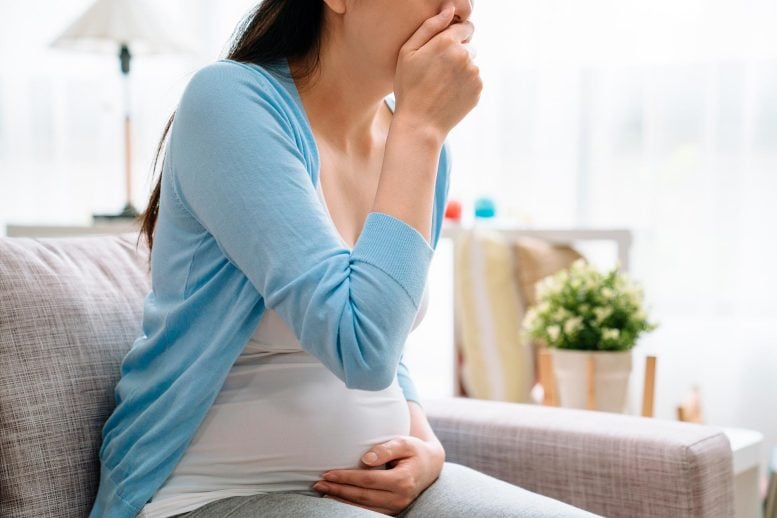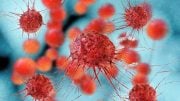
A USC and University of Cambridge study links the hormone GDF15 to pregnancy sickness, finding that a woman’s sensitivity and prior exposure to this hormone determine the severity of nausea and vomiting. Potential treatments include lowering GDF15 levels or pre-pregnancy hormone priming.
A team of researchers from the United States, United Kingdom, and Sri Lanka have collected extensive evidence showing the cause of pregnancy sickness: a hormone known as GDF15.
A new USC and University of Cambridge study finds that a hormone produced by the fetus – and a mother’s sensitivity to the hormone – are the cause behind nausea and vomiting of pregnancy, which, in its more extreme form can put the mother and fetus at risk.
The findings, which will be published today (December 13) in Nature, suggest that pre-pregnancy exposure to the hormone might mitigate symptoms in some women.
Nausea and vomiting have long been a forgone conclusion for expectant mothers, affecting 80% of women at some point during pregnancy. An additional 2% experience an extreme form called hyperemesis gravidarum (HG) that can lead to weight loss, dehydration, and hospitalization. But little has been known about the cause. Recently, a growing body of evidence has linked the symptoms to GDF15, a hormone produced in the placenta that increases substantially during pregnancy.
The Hormonal Link: GDF15’s Role
The new study supports the causal role of GDF15 in pregnancy sickness and reveals the role a woman’s sensitivity to the hormone has in determining the severity of her symptoms. Women exposed to lower levels of GDF15 before pregnancy experience more severe symptoms.
“We now know that women get sick during pregnancy when they are exposed to higher levels of the hormone GDF15 than they are used to,” said Marlena Fejzo, PhD, a clinical assistant professor of population and public health sciences in the Center for Genetic Epidemiology at the Keck School of Medicine and the paper’s first author.
Women who are more sensitive to the hormone get the sickest, said Professor Sir Stephen O’Rahilly, MD, co-director of the Wellcome-Medical Research Council Institute of Metabolic Science at the University of Cambridge, who led the collaboration. “Knowing this gives us a clue as to how we might prevent this from happening.”
Lowering GDF15 is one way to potentially address pregnancy sickness—and the present study provides the first human evidence that it is likely safe to do so. Another way to reduce symptoms involves exposing women to GDF15 prior to pregnancy, to “prime” or prepare them for elevated levels of the hormone once they become pregnant.
“This study provides strong evidence that one or both of those methods will be effective in preventing or treating HG,” Fejzo said.
Mounting Evidence for GDF15
Fejzo, O’Rahilly, and their team used a wide variety of approaches to clarify the link between GDF15 and pregnancy sickness, including patient genetic analyses and blood tests, studies of human cells and mice.
One key piece of evidence relates to the finding that a rare mutation in the gene that codes for GDF15 leads to abnormally low levels of the hormone throughout the body, putting women at greater risk of getting HG during pregnancy, when they are suddenly exposed to more of the hormone than they are accustomed to. But if their fetus also inherits the low-GDF15 mutation, research suggests the mother may be less likely to develop HG.
“For the first time, this interaction between mother and fetus helps explain why some women get HG during some—but not all—of their pregnancies,” Fejzo said, although additional research is needed to confirm the findings.
Along similar lines, the researchers found that patients with beta thalassemia, an inherited blood disorder that causes chronically high levels of GDF15, are largely protected against HG, as well as milder forms of pregnancy sickness.
The research team also used an animal model to explore whether exposing mothers to GDF15 before pregnancy could help prevent pregnancy sickness. Mice exposed to a high dose of GDF15, similar to levels seen in pregnancy, showed appetite loss indicative of nausea. But mice that were first exposed to a low “priming dose” of GDF15 did not show the same appetite loss after the high dose of GDF15.
For the first time in humans, the study also provides evidence that having lower GDF15 levels during a pregnancy can be safe, Fejzo said. In pregnancies where both the mother and fetus had the low-GDF15 mutation, babies were born normal and healthy, suggesting that lowering GDF15 levels during pregnancy may be another safe way to prevent HG.
Preventing Pregnancy Sickness
The next step for the research team is to test whether priming women with GDF15 exposure prior to pregnancy can reduce nausea and vomiting or even prevent HG. Fejzo is now applying for funding to test whether metformin, a drug that increases GDF15 levels, is safe for use in patients who have a history of HG.
The researchers also hope to test an additional class of drugs that may help with HG by blocking GDF15 from binding to its receptor in the brain. Several such drugs are already in clinical trials for cachexia (a complex metabolic condition that causes extreme weight loss) and for cancer patients with nausea and vomiting.
Fejzo, who has firsthand experience with HG, said these findings offer hope for women who like her have experienced severe illness during pregnancy.
“Hopefully, now that we understand the main cause of HG, we’re a step closer to developing effective treatments to stop other mothers from going through what I, and many other women, have experienced,” she said.
Reference: “GDF15 linked to maternal risk of nausea and vomiting during pregnancy” by M. Fejzo, N. Rocha, I. Cimino, S. M. Lockhart, C. J. Petry, R. G. Kay, K. Burling, P. Barker, A. L. George, N. Yasara, A. Premawardhena, S. Gong, E. Cook, D. Rimmington, K. Rainbow, D. J. Withers, V. Cortessis, P. M. Mullin, K. W. MacGibbon, E. Jin, A. Kam, A. Campbell, O. Polasek, G. Tzoneva, F. M. Gribble, G. S. H. Yeo, B. Y. H. Lam, V. Saudek, I. A. Hughes, K. K. Ong, J. R. B. Perry, A. Sutton Cole, M. Baumgarten, P. Welsh, N. Sattar, G. C. S. Smith, D. S. Charnock-Jones, A. P. Coll, C. L. Meek, S. Mettananda, C. Hayward, N. Mancuso and S. O’Rahilly, 13 December 2023, Nature.
DOI: 10.1038/s41586-023-06921-9
In addition to Fejzo and O’Rahilly, the study’s other authors are Victoria Cortessis, Patrick Mullin, Emmy Jin, Alyssa Kam and Nicholas Mancuso from the Keck School of Medicine of USC; Kimber McGibbon, from the Hyperemesis Education and Research Foundation; Nuno Rocha, Irene Cimino, Sam Lockhart, Clive Petry, Richard Kay, Keith Burling, Paul Barker, Amy George, Sung Gong, Emma Cook, Debra Rimmington, Kara Rainbow, Dominic Withers, Fiona Gribble, Giles Yeo, Brian Lam, Vladimir Saudek, Ieuan Hughes, Ken Ong, John Perry, Amy Sutton-Cole, Miriam Baumgarten, Steve Charnock-Jones, Anthony Coll, Claire Meek and Gordon Smith from the University of Cambridge; Nirmani Yasara and Sachith Mettananda from the University of Kelaniya, Sri Lanka; Anuja Premawardhena from North Colombo Teaching Hospital, Kadawatha, Sri Lanka; Archie Campbell and Caroline Hayward from the University of Edinburgh, Ozren Polasek from the University of Split; Gannie Tzoneva from Regeneron Genetics Center; and Paul Welsh and Naveed Sattar from the University of Glasgow.
This work is supported primarily by the Medical Research Council UK and National Institute for Health and Care Research UK (SOR). Additional funding sources are detailed in the publication.
Disclosure: Marlena Fejzo is a paid consultant for Materna Biosciences, Inc., NGM Biopharmaceuticals, and a Board member and Science Advisor for the Hyperemesis Education and Research Foundation.









Be the first to comment on "Morning Sickness Mystery Solved: Researchers Identify Key Cause and Potential Treatment"